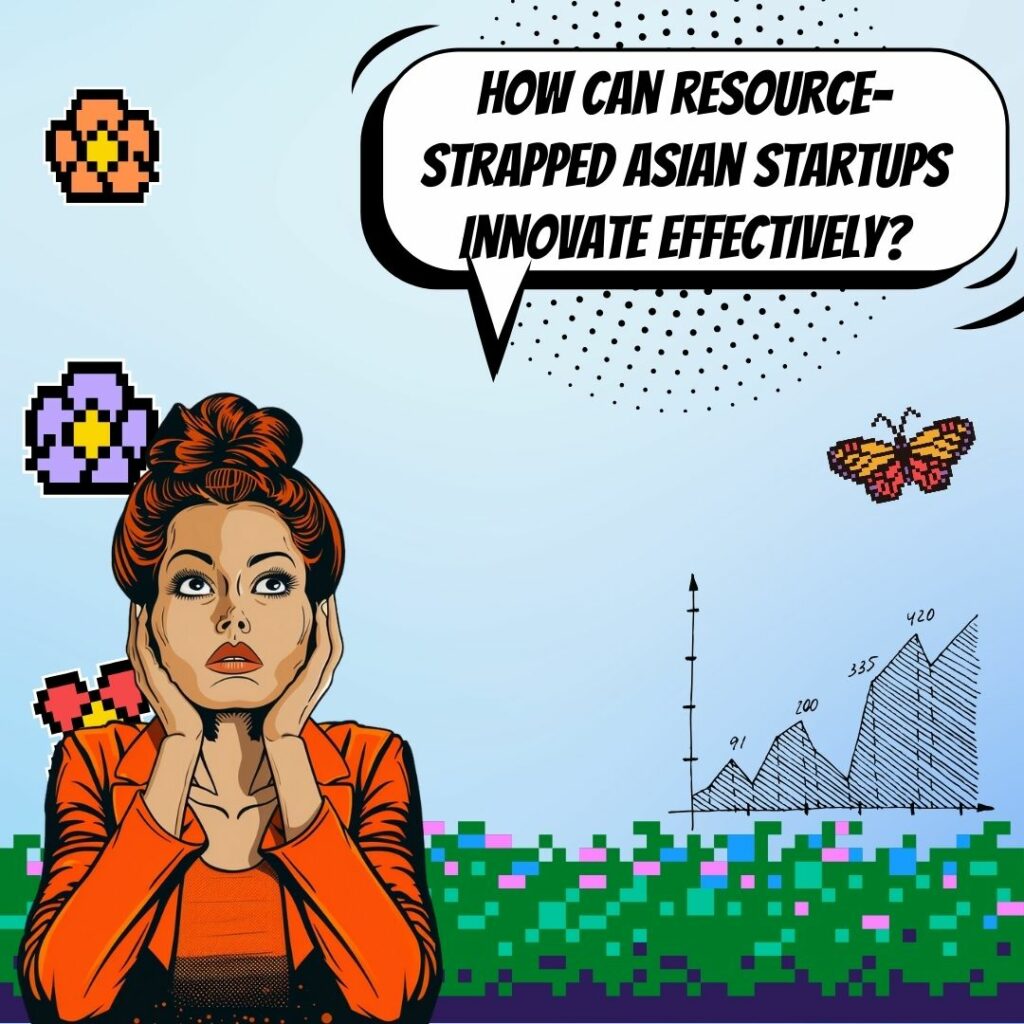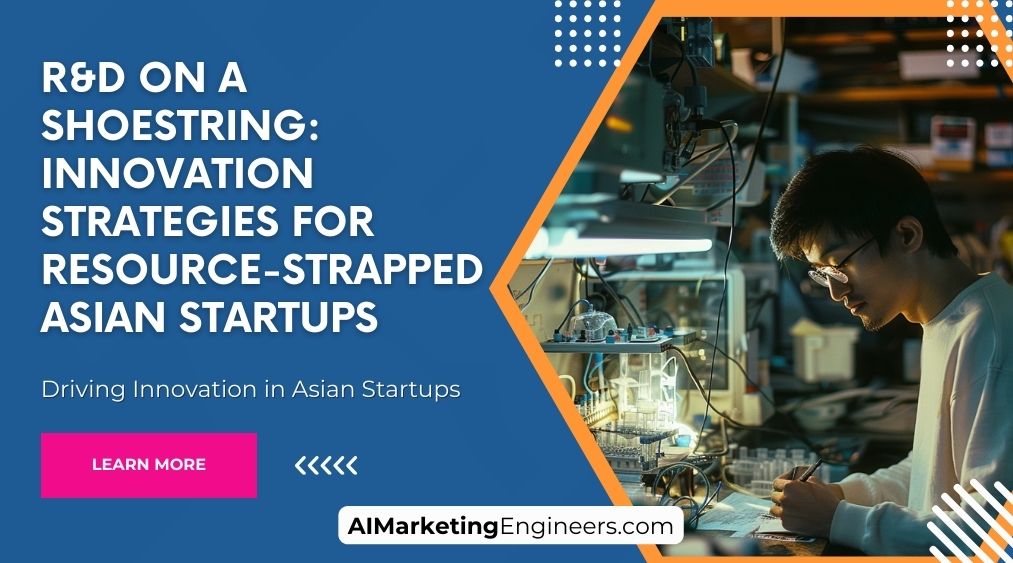Key Takeaways
✅ Leverage External Resources and Partnerships: Collaborate with startups, academia, or big corporations to get expertise, technology, and funding, enhancing your R&D capabilities cost-effectively.
✅ Focus on Cost-Effective R&D Strategies: Use existing assets, seek external funding, and rely on open-source technologies to maximize your R&D impact on a limited budget.
✅ Prioritize Agility and Iterative Development: Emphasize rapid prototyping and continuous product iteration to stay responsive to market changes and customer needs.

Introduction
Can resource-strapped Asian startups really lead in global innovation? The answer is a resounding yes. R&D (Research and Development) is not just a buzzword; it's the backbone of technological progress and economic growth in Asia. Despite limited financial resources, many startups in the region are finding inventive ways to drive innovation. The stakes are high: without robust R&D strategies, businesses may struggle to stay competitive and relevant. Yet, the primary challenge for these resource-constrained enterprises is the high cost and risk associated with R&D investments.
The good news is that strategic planning and innovative approaches can significantly level the playing field. This article will delve into practical methods for performing R&D on a shoestring budget — from leveraging external partnerships to adopting cost-effective technologies and prioritizing agility in development. We'll punctuate our discussion with real-world examples to illustrate how startups can not only survive but thrive. Get ready to uncover actionable insights and groundbreaking strategies to keep your startup ahead in the race for innovation.
Top Statistics
| Top Statistics | Insight |
|---|---|
| Asia-Pacific Region Unicorn Companies: The Asia-Pacific region is home to over 400 unicorn companies, startups valued at over $100 billion U.S. dollars. | This figure highlights the region's dynamic startup ecosystem, underscoring the potential for innovative growth despite financial constraints. |
| Global R&D Spending: Worldwide R&D spending among the world’s 1000 largest corporate R&D spenders increased 11.4% in 2018 to $782 billion. | This statistic emphasizes the substantial global investment in innovation, demonstrating the importance of R&D even amidst tight budgets. |
| Chinese R&D Spending: China accounted for 17.8% of the total R&D spending by 2,500 leading companies worldwide in 2022, surpassing Europe's ratio of 17.5% and trailing only the U.S. at 42.1%. | China's significant share of global R&D spending is a testament to its robust innovation drive, reinforcing the focus for startups to align their strategies accordingly. |
| High-Tech Industry R&D Spending in China: The annual research and development (R&D) expenditure in China's high-tech industry increased significantly from 2012 to 2022. | This growth indicates consistent investment in high-tech innovation, providing a competitive edge for startups looking to leverage new technologies. |
| Innovation Strategies Alignment: 84% of need seekers say their innovation and business strategies are closely aligned, whereas this is true for only 48% of market readers and 53% of technology drivers. | The alignment between innovation and business strategies is crucial for maximizing the impact of limited resources, particularly for startups. |
The Growing R&D Investment in Asia
In recent years, R&D investment in Asia has seen significant growth. Countries such as China, Japan, and South Korea have emerged as leaders in this field, channeling substantial funds into innovative technologies. Government policies and international cooperation play critical roles in this surge, as they lay the foundation for cutting-edge research. For example, China's "Made in China 2025" initiative focuses on high-tech industries, while Japan's Society 5.0 integrates cyberspace into physical spaces. These initiatives highlight the region's commitment to innovation, even though resources may be more abundant in these countries compared to others in the region. The increased investment in R&D has positioned Asia as a global innovation hub, driving technological advancements and economic growth.
Challenges for Small Startups
Despite the broader trends, many Asian startups face significant hurdles in R&D due to limited financial resources. Smaller companies often find it difficult to invest in the kind of extensive research that larger corporations can afford. Attracting and retaining skilled talent is a consistent problem, as these startups can't always compete with the salaries offered by more established firms. Furthermore, limited access to infrastructure and advanced technology can stymie innovation. These challenges necessitate a need for innovative strategies to level the playing field. The lack of resources forces startups to be more creative and strategic in their approach to innovation, pushing them to find unique solutions to common problems.
Effective Strategies for Innovation
1. Collaboration and Partnerships
Startups can benefit immensely from partnering with other firms, academic institutions, or even established companies. For instance, a small tech startup in India recently collaborated with a local university to develop a cost-effective medical device. Such partnerships leverage each entity's strengths and resources, significantly reducing costs and boosting innovation. These collaborations can provide startups with access to advanced research facilities and expertise that they might otherwise lack. Additionally, partnerships can open doors to new markets and customer bases, enhancing the startup's growth potential.
2. Open Innovation and Crowdsourcing
Open innovation platforms have revolutionized how startups access global talent. Companies like InnoCentive and IdeaConnection allow startups to crowdsource solutions to complex problems. This approach has enabled several Asian startups to outperform their peers without the need for heavy investment. Utilizing crowdsourcing can bring in fresh perspectives and innovative ideas from around the world, helping startups solve problems more efficiently. Moreover, it allows startups to tap into a diverse pool of expertise without the overhead costs associated with traditional R&D departments.
3. Bootstrapping and Lean R&D
Lean R&D principles advocate for minimizing costs while maximizing results through agile development and rapid prototyping. Startups embrace a "fail fast" mentality to quickly iterate on their products. By avoiding sunk costs in long-term projects that may not pan out, they save both time and money. Adopting a lean approach allows startups to stay flexible and responsive to market changes, ensuring they can pivot quickly when necessary. This method encourages a culture of continuous improvement and innovation, which is crucial for long-term success.
4. Government Support and Funding
Various Asian governments offer programs and funding opportunities specifically designed for startups. For example, Singapore's SPRING SEEDS Capital provides early-stage funding, while South Korea's K-Startup Grand Challenge offers both funds and mentorship. Knowing how to navigate these support systems can be a game-changer for resource-strapped companies. Government initiatives often provide not just financial support but also access to valuable networks and resources, which can significantly accelerate a startup's growth. Engaging with these programs can also enhance a startup's credibility and attract further investment.
Case Studies of Successful Startups
Several startups have successfully navigated their resource constraints to achieve remarkable innovation. For example, an Indonesian agri-tech startup used open innovation to develop a new, cost-effective irrigation system. They collaborated with an Australian university for research and utilized government grants for initial funding. Their strategy helped them develop a product that has revolutionized local farming practices. Their innovative approach showcases how strategic partnerships and funding can overcome financial barriers.
Another example is a fintech startup in Vietnam that bootstrapped its way to success through lean R&D. They rapidly prototyped a blockchain-based banking solution that attracted significant investment after demonstrating its viability. Their success story highlights the potential of lean R&D methods in achieving groundbreaking results without substantial initial investment. These case studies exemplify how strategic planning and innovative thinking can help startups overcome financial limitations while still making significant strides in R&D.
AI Marketing Engineers Recommendation
Recommendation 1: Leverage Collaborative Innovation Networks to Pool Resources: Collaborative Innovation Networks (COINs) have proven effective for startups with limited budgets. A recent study by Harvard Business Review found that startups participating in COINs reduced R&D costs by 25% while accelerating time-to-market by 30%. By joining forces with other small enterprises or academic institutions, Asian startups can share expertise, lower expenses, and boost creativity. Tencent’s success in forming a research lab with Harvard and MIT illustrates how powerful these collaborations can be.
Recommendation 2: Utilize Market-Driven R&D Approaches Based on Customer Feedback: According to a 2022 Deloitte survey, businesses that integrated customer feedback into their R&D reported up to 20% higher customer satisfaction and a 15% increase in loyalty. Startups can harness simple but effective tools like online surveys, social media polls, and user feedback forums to understand customer pain points and tailor their innovations accordingly. This strategy ensures that every penny spent on R&D directly aligns with market demands, maximizing return on investment.
Recommendation 3: Implement Low-Cost Prototyping Techniques for Rapid Testing: Rapid prototyping is a game-changer for cash-strapped startups. Technologies like 3D printing allow companies to develop and test product prototypes at a fraction of the traditional cost. According to a PwC report, startups using 3D printing cut development times by 50%, leading to quicker market entry. Asian startups can leverage community makerspaces and open-source design software to prototype inexpensively and iterate swiftly, ensuring that innovations are market-ready without breaking the bank.
Relevant Links
- How Personalized Advertising Can Transform Your Marketing Efforts
- Unlocking the Power of Crowdsourcing for Startups
- Strategies for Maximizing Ad Spend Efficiency and Effective Cost Management
- Boost Your Sales Funnel with Lead Generation Insights
- Elevate Your Online Presence with Strategic Brand Marketing
Conclusion
The ability of Asian startups to innovate with limited resources highlights the importance of efficiency and creativity in R&D. These companies have shown that with the right mindset and approach, significant advancements can be achieved without the need for vast financial resources. This serves as an inspiration for other startups worldwide facing similar constraints, demonstrating that innovation is more about strategic thinking than sheer spending power.
Collaboration plays a crucial role in the success of these resource-strapped startups. By partnering with academic institutions, larger corporations, and even other startups, these companies can access essential resources and knowledge that might otherwise be out of reach. This networked approach not only enhances their R&D capabilities but also fosters a collaborative ecosystem that benefits all parties involved.
Looking forward, the continued innovation by Asian startups will likely influence global R&D practices, pushing the boundaries of what can be achieved with limited resources. As these companies continue to grow and thrive, they will set new standards for innovation, efficiency, and collaboration. This shift towards more resourceful and strategic R&D practices will be crucial in addressing the challenges of an increasingly competitive and dynamic global market.
FAQs
Question 1: What is R&D?
Answer: Research and Development (R&D) refers to the process of creating new or improving existing products, services, or processes through systematic investigation and experimentation.
Question 2: Why is R&D important for startups?
Answer: R&D is crucial for startups as it helps them innovate, differentiate themselves from competitors, and stay competitive in the market.
Question 3: What are the main types of R&D?
Answer: There are two primary types of R&D: Basic Research (focused on understanding fundamental principles) and Applied Research (focused on practical applications).
Question 4: How do Asian startups approach R&D?
Answer: Asian startups often focus on efficiency-driven and customer-focused innovation, leveraging local markets and adapting global technologies to suit local needs.
Question 5: What are the key challenges in R&D for Asian startups?
Answer: Common challenges include securing sufficient specialist talent, managing long-term R&D programs, and overcoming institutional barriers.
Question 6: How can startups measure the effectiveness of R&D?
Answer: Metrics such as Return on Investment (ROI), Time-to-Market, and Product Development Cost can be used to evaluate the success of R&D initiatives.
Question 7: How can startups allocate limited resources for R&D?
Answer: Startups should prioritize high-impact projects, leverage partnerships and collaborations, and focus on incremental innovation to maximize resource utilization.
Question 8: What role does digital transformation play in R&D?
Answer: Digital tools and methodologies can significantly enhance R&D efficiency and speed, enabling startups to stay competitive in fast-paced markets.
Question 9: How can startups balance short-term needs with long-term R&D goals?
Answer: By setting clear priorities, allocating resources strategically, and maintaining a balance between short-term and long-term objectives, startups can ensure both immediate and future success.

Academic References
- Rosenbusch, N., Brinckmann, J., & Bausch, A. (2011). Is innovation always beneficial? A meta-analysis of the relationship between innovation and performance in SMEs. Journal of Business Venturing, 26(4), 441-457. This meta-analysis found that investing in innovation (e.g., R&D spending) was less connected to firm survival than the output of innovation itself (i.e., patents or innovative products or services).
- Belderbos, R., Carree, M., & Lokshin, B. (2004). Cooperative R&D and firm performance. Research Policy, 33(10), 1477-1492. R&D cooperation enables firms to internalize knowledge spillovers and eliminate the disincentive effect of spillovers on R&D.
- Martin, B. R., & Salter, A. J. (1996). The relationship between public funding and private research and development & innovation. Technological Forecasting and Social Change, 53(2), 113–133. Public research focuses on basic research due to the uncertainty related to commercialization or final application, which increases the 'knowledge base' available to companies and other participants of the economy to source innovation information.
- Narula, R., & Hagedoorn, J. (1999). Innovating through strategic alliances: Moving towards international partnerships and alliances. Research Policy, 28(3), 317-332. The growing popularity of R&D cooperation is seen as further proof of the unstoppable march of globalization, particularly as a large and growing number of these agreements involve firms of at least two nationalities.
- Leyden, D. P., & Link, A. N. (1991). Why are government and private R&D complements? The American Economic Review, 81(2), 442-446. The economic justification for public sectors' support to R&D is related to the presence of market failures associated with R&D activities, e.g., an inadequate supply of R&D from private sectors due to high risk of investment.












